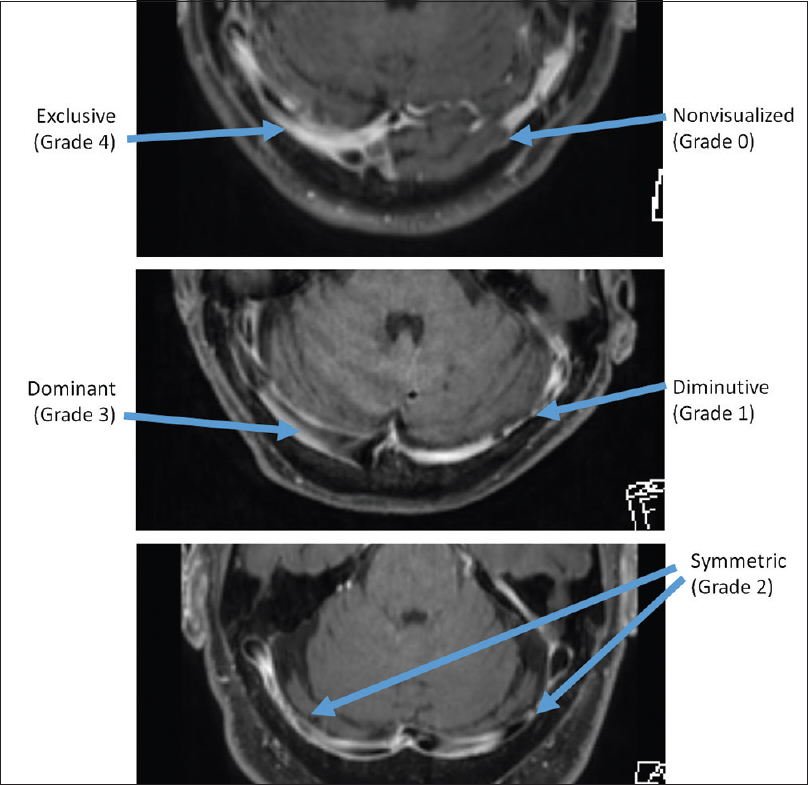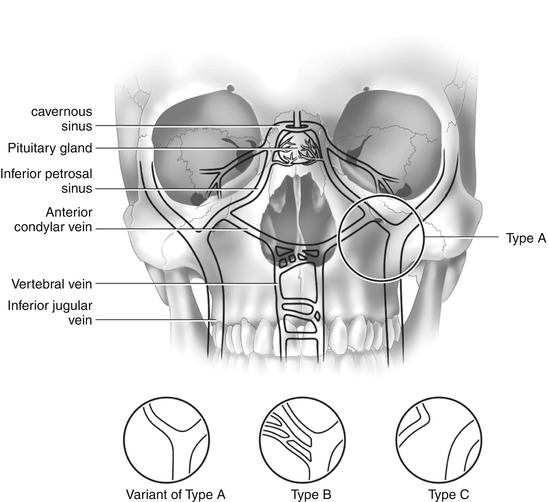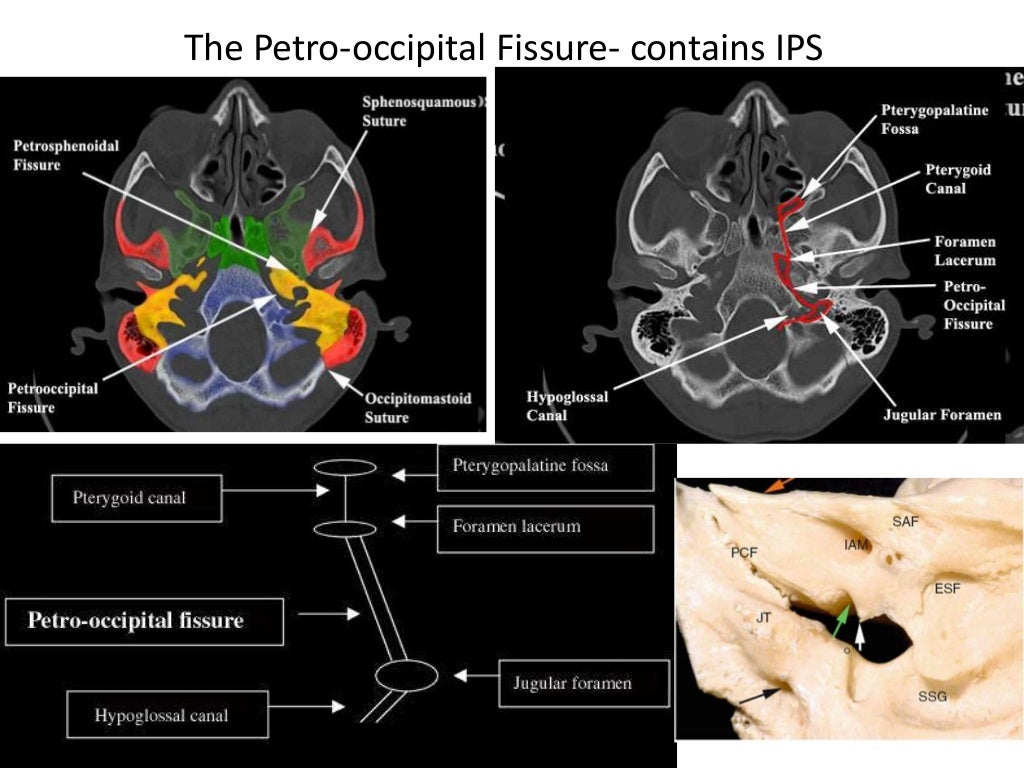
Inferior petrosal sinus provides communication between the cavernous
The inferior petrosal sinus receives the internal auditory veins and also veins from the medulla oblongata, pons, and under surface of the cerebellum. The exact relation of the parts to one another in the jugular foramen is as follows: the inferior petrosal sinus lies medially and anteriorly with the meningeal branch of the ascending pharyngeal.
:background_color(FFFFFF):format(jpeg)/images/library/13700/OjQUAVHibTE6hE6qgp8A_Sinus_petrosus_inferior_02.png)
Inferior petrosal sinus Anatomy, tributaries, drainage Kenhub
The inferior petrosal sinuses connect the cavernous sinuses with the ipsilateral internal jugular veins. The anatomy of the anastomoses between the inferior petrosal sinus, the internal jugular vein, and the venous plexuses at the base of the skull varies, but it is almost always possible to catheterize the inferior petrosal sinus.

Groove for inferior petrosal sinus (Sulcus sinus petrosi inferioris
This handout explains a procedure called inferior petrosal sinus sampling. What are the petrosal sinuses? Petrosal sinuses are a group of veins on both sides of the head. They drain blood from the pituitary gland. What is inferior petrosal sinus sampling? Inferior petrosal sinus sa mpling (IPSS) is a procedure that checks . adrenocorticotropic.

Assessment of the Inferior Petrosal Sinus on T1Weighted Contrast
BACKGROUND AND PURPOSE: Inferior petrosal sinus sampling (IPSS) is a useful diagnostic technique in adrenocorticotropic hormone (ACTH)-dependent hypercortisolism with normal or equivocal MR imaging. The procedure is believed to be safe, with mostly minor complications. However, there are rare, but severe, neurologic complications that need to be considered.

Petrosal Venous Sinus Sampling Radiology Key
The inferior petrosal sinus usually drains into the IJV around the jugular foramen and offers a connection to the anterior condylar confluent. Occasionally the termination of the inferior petrosal sinus in the IJV may be found up to 4 cm below the jugular foramen. 51 This anatomic variation has to be known by neuroradiologists attempting to navigate into the inferior petrosal sinus through the.

Inferior petrosal sinus 360°
Inferior petrosal sinus sampling is a procedure that may be required to confirm the source of ACTH-dependent Cushing's syndrome. Lab studies can often differentiate ectopic from pituitary ACTH-driven Cushing's syndrome, but it is clear that the levels, even on dynamic testing, may have some overlap.

Bilateral inferior petrosal sinus sampling experience in 327 patients
The inferior petrosal sinus is a paired cranial venous channel that drains the cavernous sinus, midbrain, cerebellum and inner ear. This dural venous sinus emerges from the cavernous sinus within the middle cranial fossa and drains into the internal jugular vein. Occasionally, it may also drain into the suboccipital external vertebral venous.

inferior petrosal sinus
Inferior petrosal sinus sampling is an infrequently used method of confirming the presence of a hormonally active pituitary microadenoma when imaging alone has been insufficient. This technique is able to confirm that excess hormone (e.g. ACTH) is being produced by the pituitary and may also help in lateralizing the microadenoma (although the.

Bilateral inferior petrosal sinus sampling procedure Download
Simultaneous bilateral inferior petrosal sinus sampling (BIPSS) plays a crucial role in the diagnostic work-up of Cushing's syndrome. It is the most accurate procedure in the differential diagnosis of hypercortisolism of pituitary or ectopic origin, as compared with clinical, biochemical and imaging analyses, with a sensitivity and specificity of 88-100% and 67-100%, respectively.

Inferior petrosal sinus sampling Image
The inferior petrosal sinus is situated in the inferior petrosal sulcus, formed by the junction of the petrous part of the temporal bone with the basilar part of the occipital bone. It begins below and behind the cavernous sinus and, passing through the anterior part of the jugular foramen, ends in the superior bulb of the internal jugular vein.

Relationship between inferior petrosal sinus, cavernous sinus and
The inferior petrosal sinus receives several tributaries prior to merging with the sigmoid sinus to form the internal jugular vein. For instance, it receives labyrinthine veins and tributaries from the medulla oblongata, pons, and inferior cerebellar surfaces. Structures Drained.

Image
The inferior petrosal sinus (IPS) occupies an important position at the skull base and must be considered with surgical approaches to this area. Moreover, more recent, minimally invasive intravascular procedures necessitate sampling blood from this sinus. Therefore, detailed knowledge of its anatomy and variations is important in clinical practice.

The angiography of inferior petrosal sinus in a true positive patient
1, transverse sinus; 2, sigmoid sinus; 3, inferior petrosal sinus; 4, superior petrosal sinus; 5, petrosquamosal sinus; 6, middle meningeal sinus draining into the cavernous sinus and the pterygoid venous plexus via the foramen ovale (small arrow); 7, retromandibular vein draining into the external jugular vein; 8, sinus communicans.

Petrosal Sinuses Human Anatomy Kenhub YouTube
The inferior petrosal sinus is one of the dural venous sinuses. It is often a plexus of venous channels rather than a true sinus and drains blood from the cavernous sinus to the jugular bulb through the jugular foramen (pars nervosa) or sometimes via a vein which passes through the hypoglossal canal to the suboccipital venous plexus.

E043 Anatomical characterization of the inferior petrosal sinus and
The function of the superior petrosal sinus is to drain the venous blood from the brainstem, temporal lobe of cerebrum, cerebellum, middle and inner ear into the transverse sinus. It does so by collecting the blood from the superior petrosal, cerebellar, inferior cerebral, tympanic, and at times, labyrinthine veins.

Anatomical characterization of the inferior petrosal sinus and adjacent
Inferior petrosal sinus catheterization is usually used as a venous access to the cavernous sinus dural arteriovenous fistula and it is also used for sampling for corticotropin dosage and helps to differentiate hypophisary and ectopic forms of Cushing syndrome. 1 -5 Knowledge of this vessel's exact anatomy may be useful to endovascular specialists. . The aim of this paper is to describe the.